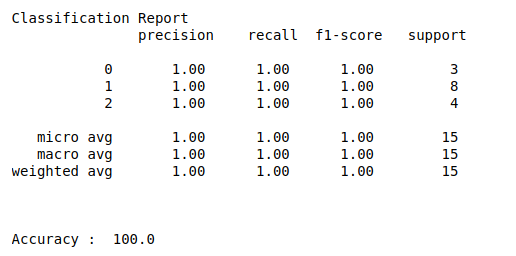To build a deep neural network model for a classification problem in python.
Iris Data set.
Confusion matrix
Classification report
Accuracy score
Precision and recall
Load the data set.
Define the independent and dependent variable.
Build the deep neural networks.
Initiate activation and optimizer functions according to the problem.
Split the data into train and testing set..
Fit the training set into the model.
Predict the test results using DNN.
Calculate the accuracy, precision and recall.
#import necessary libraries
import time
import random
import warnings
warnings.filterwarnings(“ignore”)
import pandas as pd
import numpy as np
import matplotlib.pyplot as plt
import seaborn as sns
from keras.models import Sequential
from keras.layers import Dense
from keras.models import Model
from sklearn.model_selection import train_test_split
from keras.utils import np_utils
from sklearn.metrics import classification_report, confusion_matrix
#load the sample data from csv file
data = pd.read_csv(‘………..file path………/iris.csv’)
#Make it as a data frame
df = pd.DataFrame(data)
#shape of data
print(“Rows and columns of data\n”,df.shape)
print(“\n”)
#feature selection
X = df.iloc[:,0:4]
y = df.iloc[:,5]
#Split the data into train and testing
X_train, X_test, Y_train, Y_test = train_test_split(X, y, test_size=0.1, random_state=0)
#Print training data
print(“Training data\n”,X_train,”\n”,Y_train)
print(“\n\n”)
#Print testing data
print(“Testing data\n”,X_test)
print(“\n\n”)
#make dependent variable categorical
Y_train = np_utils.to_categorical(Y_train,num_classes=3)
Y_test = np_utils.to_categorical(Y_test,num_classes=3)
batch_size = 20
#shape of input
n_cols_2 = X_train.shape[1]
#create deep neural networks
model_2 = Sequential()
#add layers to model
model_2.add(Dense(250,activation=’relu’, input_shape=(n_cols_2,)))
model_2.add(Dense(250, activation=’relu’))
model_2.add(Dense(250, activation=’relu’))
model_2.add(Dense(3, activation=’softmax’))
#Compile the model
model_2.compile(optimizer=’adam’, loss=’categorical_crossentropy’, metrics=[‘accuracy’])
#Here we train the Network.
start_time = time.time()
model_2.fit(X_train, Y_train, batch_size = batch_size, epochs = 10, verbose = 5)
end_time = time.time()
elapsed_time = end_time – start_time
print(“Time to train model: %.3f seconds” % elapsed_time)
#Evaluate the network
start_time = time.time()
score,acc = model_2.evaluate(X_test,Y_test,verbose = 2,batch_size = batch_size)
end_time = time.time()
elapsed_time = end_time – start_time
print(“Time to evaluate model: %.3f seconds” % elapsed_time)
print(“\n”)
#Predict the test results
prediction = model_2.predict(X_test)
length = len(prediction)
y_label = np.argmax(Y_test,axis=1)
predict_label = np.argmax(prediction,axis=1)
#classification report
print(“Confusion Matrix\n”,confusion_matrix(Y_test.argmax(axis=1),prediction.argmax(axis=1)))
print(“\n”)
print(“Classification Report\n”,classification_report(Y_test.argmax(axis=1),prediction.argmax(axis=1)))
print(“\n”)
accuracy = np.sum(y_label==predict_label)/length * 100
print(“Accuracy : “,accuracy)
#Precision-recall graph
plt.rcParams[“figure.figsize”] = [16,10]
import scikitplot as skplt
probas = model_2.predict_proba(X_test)
skplt.metrics.plot_precision_recall(Y_test.argmax(axis=1), probas)
plt.title(“Precision & Recall graph for DNN model”)
plt.show()






